SureFire SOCOM300 SPS
By: Sean Utley
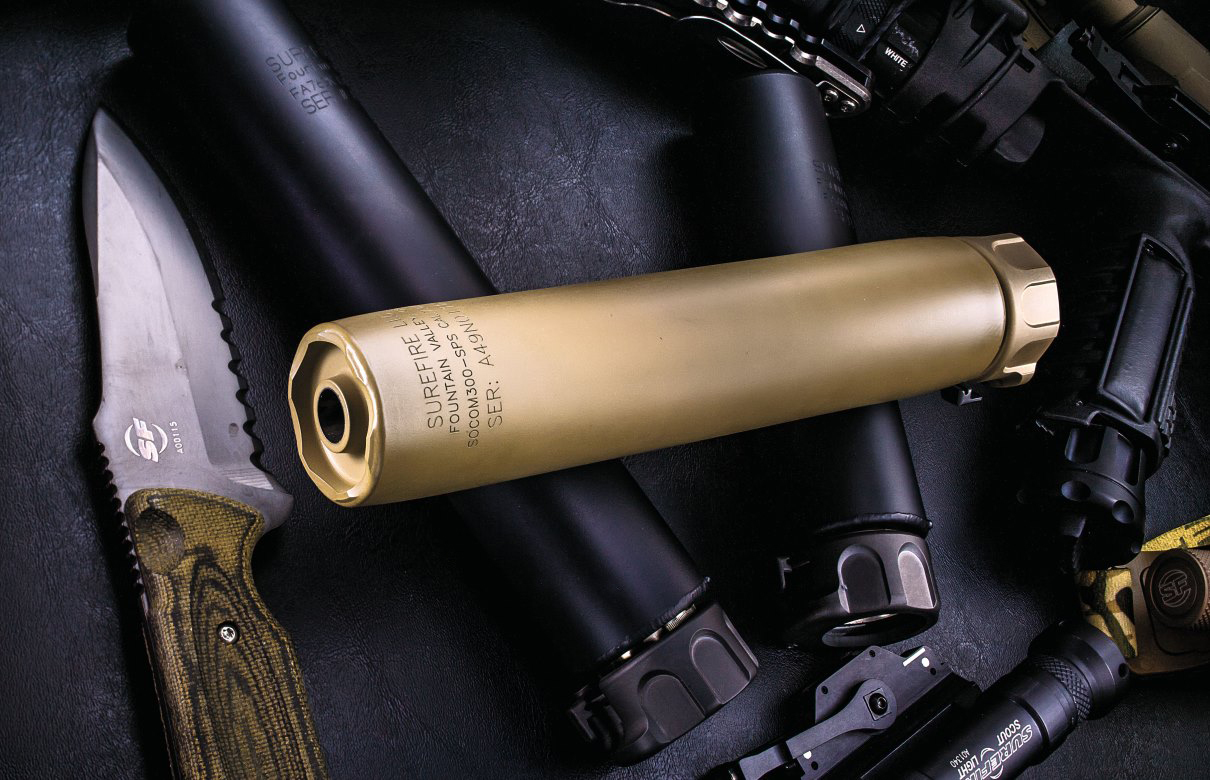 The SOCOM300 SPS features highly specialized V-shaped baffles, designed to capture more expanding gases for a significant impact on sound reduction. (Photo courtesy of "Shooting Times")
The SOCOM300 SPS features highly specialized V-shaped baffles, designed to capture more expanding gases for a significant impact on sound reduction. (Photo courtesy of "Shooting Times")
The improved - and less expensive - SOCOM 2 series
Few brand names bring stars to the eyes of fans like SureFire. SureFire has a rich history of making technologically advanced and well-built tactical lights and lasers. They also produce other lust-worthy products like their line of blades. More than likely, when you mention SureFire, one of two things comes to mind lights or suppressors.
SureFire introduced their line of suppressors at the end of 2003. Shortly afterward, they coined the phrase Total Signature Reduction (TSR). This basically means that a firearm’s sound and flash are reduced, nearly eliminating one’s ability to detect where a shot originated when a SureFire can is attached. While this may be true, it’s true for suppressors in general.
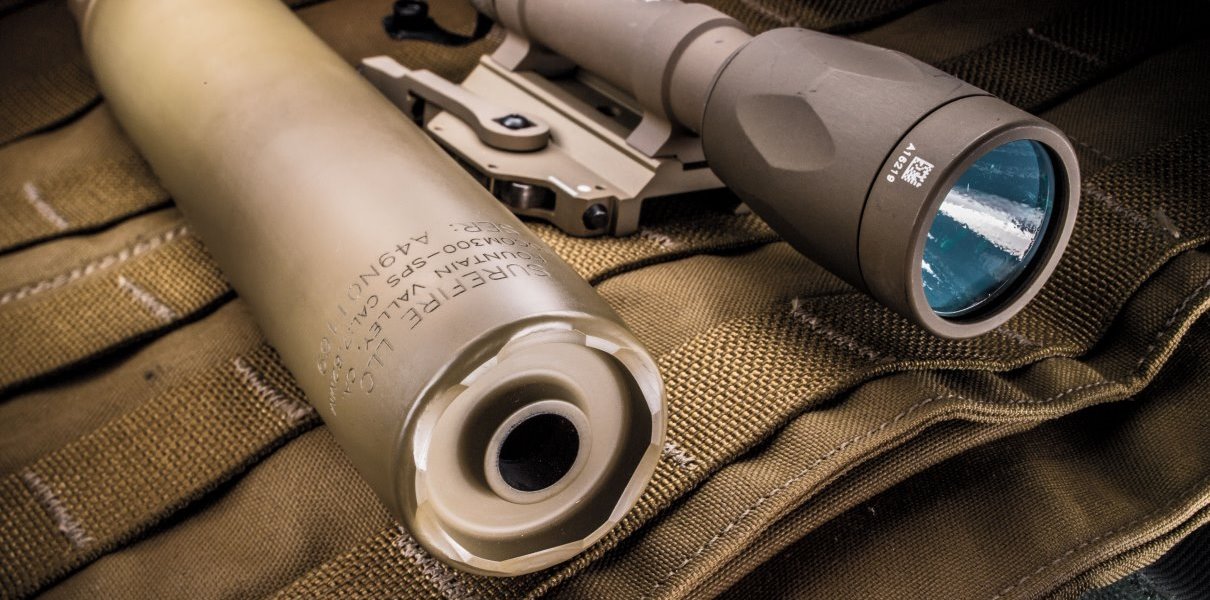
Whether it’s suppressors or mounted lights, SureFire products are synonymous with quality. (Photo courtesy of “Shooting Times”)
SureFire also marketed that shooters would experience no shift in point of impact (POI) with their suppressor attached. This claim developed into a debate because, as far as most manufacturers are concerned, there is no such thing as no POI shift when adding a suppressor. Any weight that is added to your barrel can change POI. So, a more accurate description was adopted minimal impact on point of aimpoint of impact. Suppressors have the potential to shrink group sizes, and shooters desire such an outcome. In fact, both POI shift and effect on group size are measured testing parameters in Suppressor; we go beyond the typical sound-meter testing.
New Era
SureFire’s SOCOM series of suppressors continue to be successful. Many a shooter longed to have one attached to their gun. It’s safe to say they were a status symbol – and understandably so – because of their adoption by SOCOM. Throughout years of carbine classes and training, seeing a SureFire can attached to one’s firearm brought ooohs and aaahs. So did their price tags. That topic warrants an explanation, because understanding how SureFire designs, manufactures and tests their suppressors could put cost considerations in a new light.
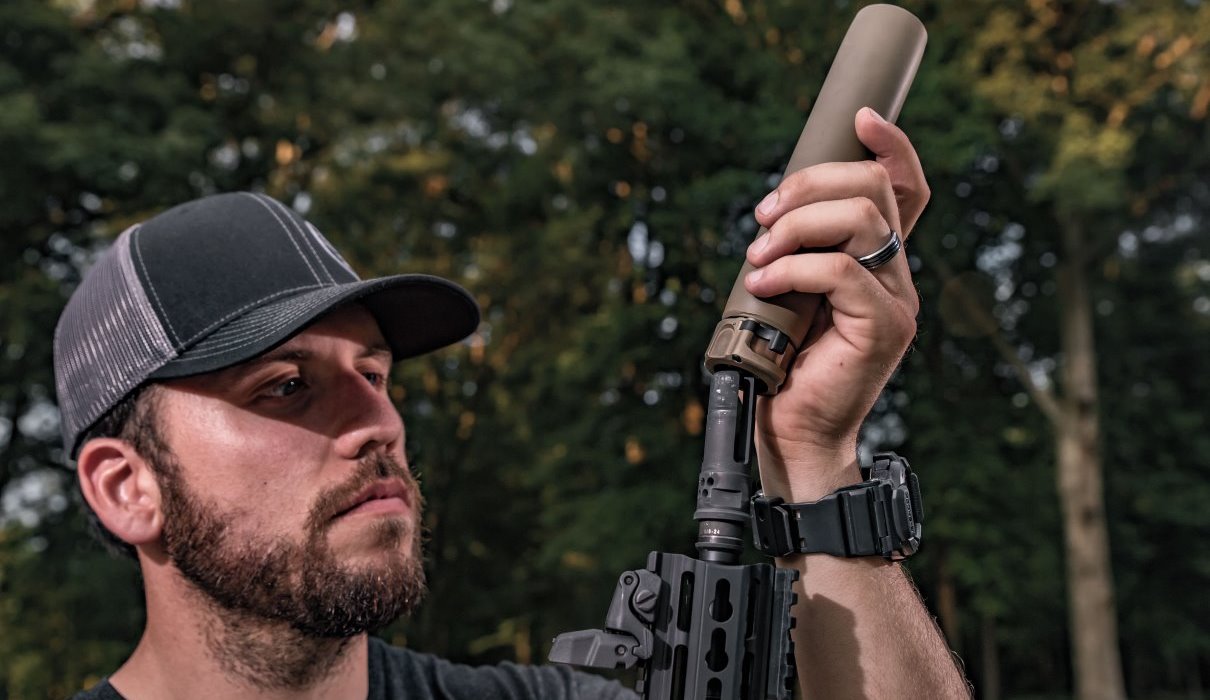
SureFire has one of the original quick-detach mounting options that is simple for the operator. (Photo courtesy of “Shooting Times”)
Chris Skahill, sales and marketing manager for SureFire’s suppressor division, told us this “All SureFire rifle, carbine and machine gun suppressors are test-fired for accuracy and quality of the product. This has been the case since the beginning and will continue to be our requirement before any product is shipped. The testing requirement is that each suppressor be fired for a three-round group within 1 MOA of an unsuppressed control group done on that same day, and the target is recorded. This does add additional time for the completion of a final product; however, this is the only way that we can ensure the utmost in quality.”
Checking all the boxes
We received a SOCOM300 SPS in flat dark earth (FDE). For most gun guys, there is a mental checklist that is referenced whenever we acquire a new product. We want it to be durable so that it will last, we obviously want it to perform well, and we want it to look good. SureFire’s SOCOM300 SPS checks all the boxes.
SOCOM300 SPS Specs
Cartridge: .300 BLK, 7.62x51, 5.56, .300 Win. Mag.
Weight: 1lb., 4.3 oz.
Length: 8 in.
Diameter: 1.5 in
Materials: Alloy, stainless steel
Mfg. Noise
Rating: >120 dB .300 BLK; 129 dB, 7.62x51; 134 dB, 7.62x51;134 dB 5.56; 137 dB .300 Win. Mag.
Attatchment Type: Fast-attach
Finish: Black, FDE
MRSP: $1,075
Manufacturer: SureFire
SureFire was one of the first companies to incorporate Inconel into their product designs. Their design approach has improved with the SOCOM 2 series. The solid blast baffle is made of Inconel, while the rest of the suppressor is made of stainless steel. Historically, SureFire has made extremely tough cans, and this one appears to be no different. The SOCOM 2 series brought manufacturing design changes that allow for computer-controlled laser welding as opposed to the conventional welding of the SOCOM series. This means production can increase while production times decrease, and quality won’t suffer. It also means a price reduction for SureFire’s SOCOM 2 cans.
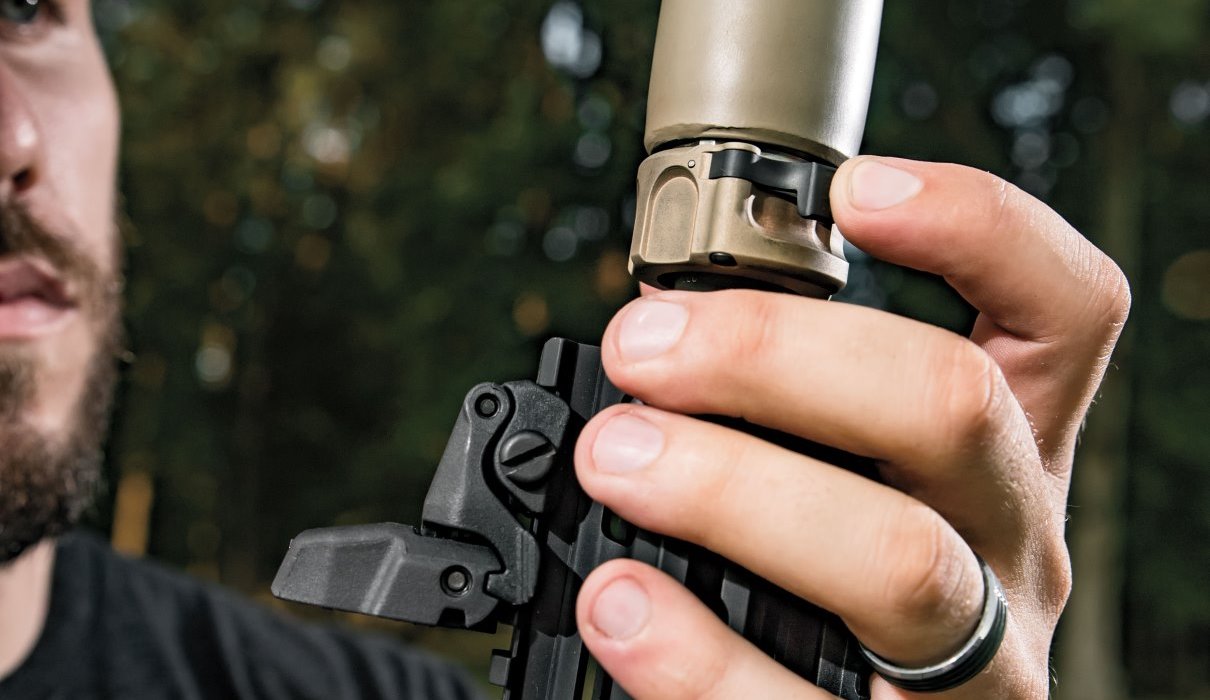
To remove the SPS, press the tab on the Fast Attach system. It’s easy to remove even after extensive firing. (Photo courtesy of “Shooting Times”)
Unsurpassed sound reduction was one of SureFire’s ultimate goals. They set out to make the 300 SPS the quietest can on the market, with a focus on .300 Blackout in both subsonic and supersonic ammunition options. On paper, the 300 SPS effectively achieves this with a claimed .300 BLK subsonic sound rating of less than 120 decibels (dB); it is still rated up to .300 Win. Mag. with a hearing-safe rating of 137 dB. In what may be the most impressive feat of the 300 SPS, SureFire rates its 7.62x51 noise reduction at 129 dB. This must be taken with a grain of salt as several factors affect sound levels, and every can will perform differently depending on atmospheric conditions, ammunition and barrel lengths. However, this is still an impressive number, and it is one of the lowest noise-reduction levels for the .308 in print.
Going the extra mile
The SOCOM300 SPS features what SureFire calls “highly specialized V-shaped baffles.” These baffles were designed to capture more expanding gases for a significant impact on sound reduction. In fact, Skahill said that there would be more back pressure with the SPS on semiautomatics. I found this interesting because, historically, SureFire suppressors exhibited less back pressure; according to the company, an average of one-third less than competing suppressors. Though the 300 SPS is at home on .300 Win. Mag. and .308 firearms, it is specifically targeted for use on the .300 BLK because of that caliber’s reduced pressures. Skahill also stressed just how quiet the can is and emphasized its optimal performance on .300 BLK SBRs.

The indexing point on the bottom of SureFire’s muzzle devices aids in proper suppressor alignment before cinching it down. (Photo courtesy of “Shooting Times”)
SureFire’s marketing prowess shouldn’t be overlooked, and they may be single-handedly respons-?ible for making fast-attach/detach suppressors “cool.” The question remains Is this fast-attachdetach capability a must I questioned this, and Skahill replied that it’s a matter of long-term strength and reliability, informing me that threads can stretch and change with repeated attachment and removal of a direct-thread suppressor. This could affect concentricity. SureFire’s attachment system remains one of the best and easiest to use in the industry. They also offer several muzzlebrakeflash hider options. SureFire goes to great lengths to ensure that your muzzlebrake will be properly timed by providing excellent installation instructions. They even provide a timing diagram that highlights how your muzzle device should be oriented and which washers to use for proper alignment. Going a step further, the washers are color-coded for ease of use. While timing a muzzle device is not rocket science, it can sometimes be a frustrating experience and every advantage helps.
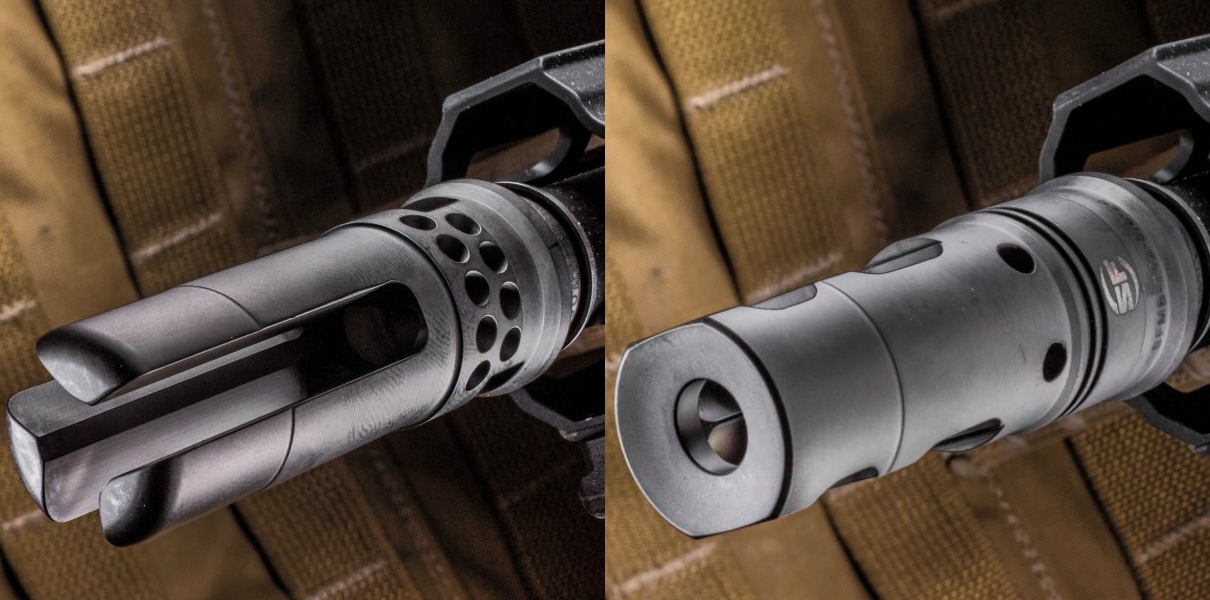
SureFire suppressor adaptors are available in their Warcomp flashers and SOCOM muzzlebrakes. (Photo courtesy of “Shooting Times”)
As you would expect with any SureFire product, aesthetics are on-point and the 300 SPS is simply beautiful, with an emphasis on simple. The FDE coating is silky in appearance, flawlessly applied, and we always opt for FDE if given a choice. Anyone familiar with suppressors can identify a SureFire immediately – in a sea of metal tubes, they’ve successfully set themselves apart visually.
Testing
Adhering to SureFire’s printed material, the 300 SPS was attached to a short-barreled .300 Blackout Primary Weapons Systems MK109. The MK109 has an ideal barrel length of 9¾ inches for the .300 BLK. This length allows for all of the cartridge’s powder to be burned, exploiting what the .300 BLK is all about.
Performance SOCOM300 SPS
| Primary Weapons Systems MK109 Nosler Match Grade Ballistic Tip 125-grain BT |
Avg.
Group (in.) |
Best
Group (in.) |
| Unsuppressed |
2.59 |
1.85 |
| Suppressed |
1.81 |
1.2 |
POI Shift: None
Tested Average Noise Reduction: 220 gr. -30.66dB; 125 gr. -30.54dB
Testing Conditions: 78 degrees, 55 percent humidity, 869 feet. Accuracy is the average of three, five-shot groups shot from 100 yards.
Nosler Ballistic Tip 125-grain BT .300 BLK ammunition was shot suppressed and unsuppressed. And because it’s almost a must, we also accuracy tested 220 grain – suppressed only, since the firearm will not function with this load without a suppressor attached.
The best unsuppressed group measured 1.8 inches, while the best suppressed group was 1.2 inches. Average group sizes improved by over three-quarters of an inch as well. It’s clear that the SureFire 300 SPS was having a positive effect on the performance of the MK109. There was no measurable change in POI either.
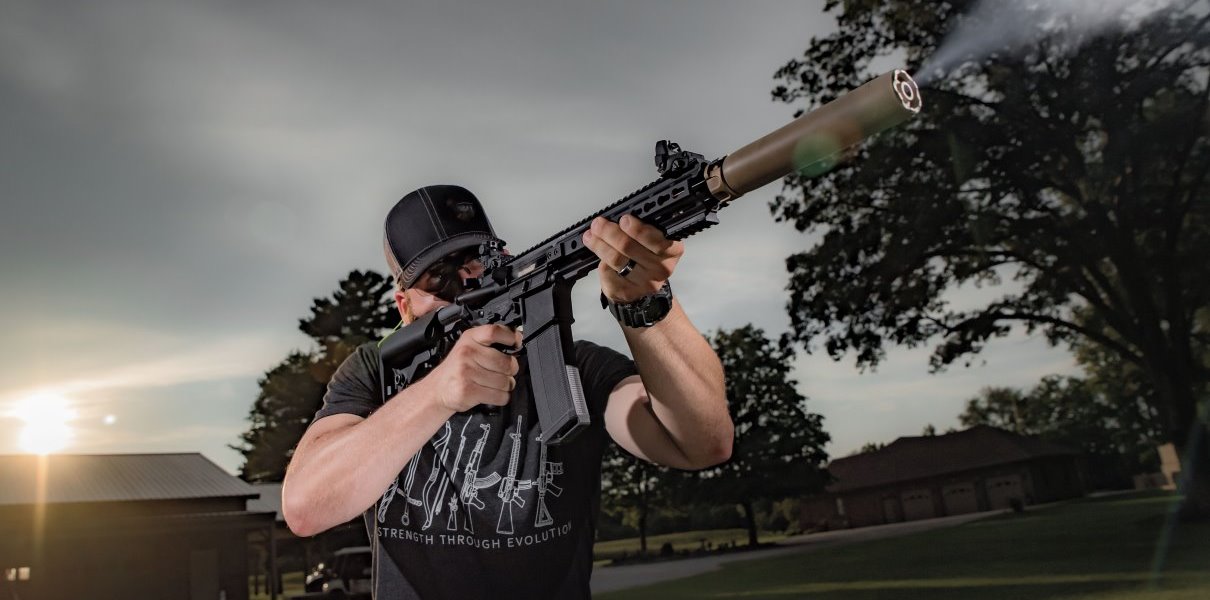
.300 SPS attached to a short-barreled .300 Blackout: Primary Weapons Systems MK109. (Photo courtesy of “Shooting Times”)
Conclusion
SureFire touts stringent design and testing standards. We’ve never doubted their claims, but it’s nice to be able to finally test them. The 300 SPS appears to be a solid suppressor with a multi-role personality. We’ve successfully run it on .308 and .300 Win. Mag.
If you’re a SureFire fan, none of this will be surprising. But if you’ve been cost-leery of SureFire products, maybe these results will give you peace of mind that there is a high level of effort put into making SureFire products what they are. Keep in mind that this suppressor retails for just under $1,100. We’d say it’s well worth the money.